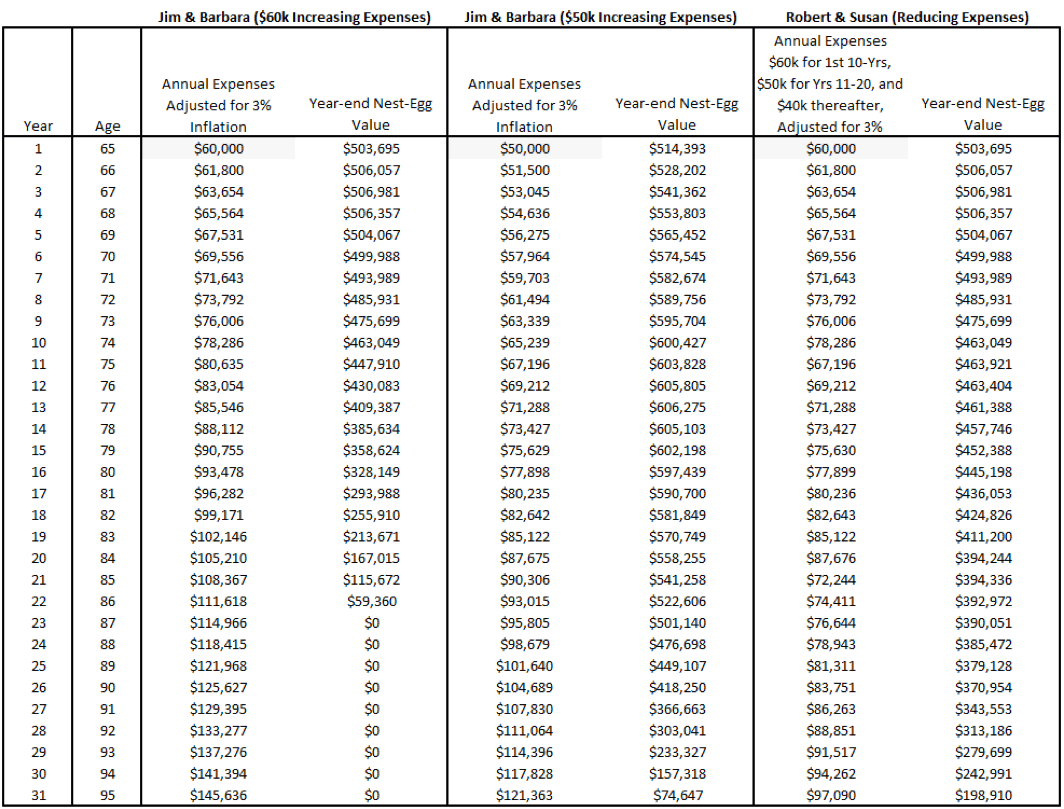Will You Spend Less in Retirement Than You Think?
It's smart to budget for inflation. But if you're overly conservative, you may be setting yourself up for a less fun retirement or years longer working than necessary, because your retirement spending calculation may be wrong.


“How much can I spend each year during retirement?” Retirement-planning software and statistics clash on this point.
If you, or your adviser, are using retirement software to determine your recommended spend rate in retirement, it is highly possible that the projections are inaccurate. These miscalculations could put unnecessary limits on the amount you can spend during your early (and healthier) years of retirement. In addition, these potential errors could suggest that your nest-egg needs to be much larger than is needed, forcing you to stay in the workforce longer than you have to.
If you are a retiree, or soon-to-be retiree, understanding these potential inaccuracies could help you better determine when you can comfortably retire, and adjust your spend rate to make the most out of your retirement as you age.

Sign up for Kiplinger’s Free E-Newsletters
Profit and prosper with the best of expert advice on investing, taxes, retirement, personal finance and more - straight to your e-mail.
Profit and prosper with the best of expert advice - straight to your e-mail.
Traditional Planning
Retirement-planning software requires you to input an assumed retirement inflation rate. Most software defaults to 3%, which is roughly the 100-year average in the U.S. That means the software is going to assume that you will need 3% more money every year to buy the same things you bought in the previous year. For example, if you need $60,000 this year to cover your expenses, next year you’ll need $61,800 to buy the same things, and $63,564 the next year and so on.
At that 3% pace, you’ll need $108,367 20 years from now to buy what $60,000 buys today. These projections should work out beautifully if we do, in fact, experience 3% inflation. But life’s not that simple.
The Facts
Even though inflation should always be a consideration in your retirement planning, you shouldn’t let it scare you into unnecessarily overworking and underspending, because research by the U.S. Bureau of Labor Statistics (BLS) suggests that folks actually spend less as we get older, rather than more. While our spending on things like health care increases somewhat during retirement, it is more than offset by a decrease in things like housing, food, clothing, transportation and entertainment.
According to the BLS, there is a spending decrease of 17% between ages 55-65 and ages 65-75, and another decrease of 24% for those over age 75, vs. their age 65-75 counterparts. And that’s more than enough to cover for rising prices, when compared to inflation’s historical average.
So, for someone who is age 55-65 and needs $60,000 to cover their annual living expenses, the BLS numbers suggest that they will likely need 17% less, or $49,800, between age 65-75, and then $37,848 after age 75 (assuming today’s dollars). The BLS numbers don’t suggest that there isn’t inflation experienced during retirement, but rather that we simply buy fewer things.
Comparison
So, let’s look at the difference between someone planning on rising expenses or falling expenses during retirement. Let’s assume we have two couples, both age 65, and both needing $60,000 to cover their retirement expenses (chart below). Both couples receive $36,000 from Social Security, $20,000 from a pension before tax, and the balance of what they need from their $500,000 IRA portfolios. We are also assuming a life expectancy of age 95, a 5% rate of return and an 18% nominal income tax rate.
Constant Rising Expenses (Traditional Projections)
Jim and Barbara are using traditional retirement projections with a 3% inflation assumption. With this conventional wisdom they are assuming they will need 3% more money every year to cover their living expenses. By age 75 they assume they will need $80,635 to cover their expenses and by 85 that will rise to $108,367. Based on these assumptions, Jim and Barbara’s portfolio will be completely depleted at age 87. As their adviser, if I stopped at this point, I’d have to suggest that they continue working and building their portfolio, or decrease their spending to $50,000.
Falling Expenses
Robert and Susan have developed a more detailed analysis and are assuming their expenses will fall at different points during retirement. Using the BLS numbers as their guide, they have determined they will need $60,000 for the first 10 years of retirement, $50,000 for years 11 through 20, and $40,000 thereafter (adjusted for 3% inflation). Using these assumptions, their analysis indicates that they will have $392,972 left at age 86 and $198,910 left at 95. If Robert and Susan wanted to be even more aggressive in their spending, they could spend an additional $5,000 per year for the first 10 years of retirement without running out of money by age 95.

Being Conservative Comes at a Cost
If you take the conventional wisdom, a constant 3% increase per year throughout retirement, you are definitely being conservative. However, you may be being too conservative. The cost of your conservativeness may be an unnecessary reduced spending rate early in retirement when you are healthy and able to enjoy your money. On the flip side, being conservative in your planning will help you handle the unknowns that may arise, like the added cost of a nursing home stay, lower-than-anticipated returns, living much longer than projected, higher-than-projected inflation rates, etc.
The key here is to understand the limitations of retirement calculators in light of spending trends among retirees. The closer you can estimate your actual spending, the better your analysis will be. You don’t want to look back when you are 85 and no longer physically able to do as much as you once could, and wish you would have taken a few more trips when you were younger and more healthy. You also don’t want to spend too much too soon.
I’d suggest running your projections assuming expenses are increasing over time, and also projections assuming your expenses are reducing over time. This will likely take the help of a financial professional who has access to cutting-edge software. Once you’ve run and compared the numbers, you will likely conclude, as I have, that your spending should be somewhere in between the two approaches.
Get Kiplinger Today newsletter — free
Profit and prosper with the best of Kiplinger's advice on investing, taxes, retirement, personal finance and much more. Delivered daily. Enter your email in the box and click Sign Me Up.

Ray LeVitre is an independent fee-only Certified Financial Adviser with over 20 years of financial services experience. In addition he is the founder of Net Worth Advisory Group and the author of "20 Retirement Decisions You Need to Make Right Now."
-
 Customer Services are Strained at the SSA, You Should Plan Around These Federal Holidays
Customer Services are Strained at the SSA, You Should Plan Around These Federal HolidaysIf you have a question or need information from a federal agency, check the federal holiday schedule to make sure you get your business done before they close.
By Donna LeValley
-
 Stock Market Today: No 'Powell Put'? No Problem
Stock Market Today: No 'Powell Put'? No ProblemInvestors, traders and speculators look beyond both another Trump post and more signs of slowing economic activity.
By David Dittman
-
 First 100 Days: Trump's Impact on Your Finances
First 100 Days: Trump's Impact on Your FinancesHere are some opportunities to consider regarding investing, interest rates and tax cuts as the financial landscape shifts under the new administration.
By Daniel Razvi, Esquire
-
 What Would Happen if You Put Your Tax Refund in an IRA?
What Would Happen if You Put Your Tax Refund in an IRA?Not only could you get a tax break, but the compounding effect over 35 years could turn the average refund into nearly $14,000.
By Romi Savova
-
 Children Can't Afford to Fly the Nest? Here's How to Help
Children Can't Afford to Fly the Nest? Here's How to HelpThe high cost of living means more adult children are staying at home. Here are four ways to help financially so they can eventually spread their wings.
By Kelli Kiemle, AIF®
-
 A QLAC Does So Much More Than Simply Defer Taxes
A QLAC Does So Much More Than Simply Defer TaxesHere are the multiple ways you can use a QLAC, from managing retirement risks to creating income for specific retirement needs and wants.
By Jerry Golden, Investment Adviser Representative
-
 Self-Directed Brokerage Accounts: Retirement's Hidden Gem?
Self-Directed Brokerage Accounts: Retirement's Hidden Gem?SDBAs are often overlooked, but they can offer more flexibility and growth potential inside your 401(k) when actively managed by a professional.
By Scott M. Dougan, RFC, Investment Adviser
-
 Early-Stage Startup Deals: How Does a SAFE Work?
Early-Stage Startup Deals: How Does a SAFE Work?Investing in an early-stage startup can get complicated fast, so the venture capital industry turns to other investing options. One is a SAFE.
By Murat Abdrakhmanov
-
 Should You Hire a Public Adjuster for Your Insurance Claim?
Should You Hire a Public Adjuster for Your Insurance Claim?As natural disasters strike more often, insurance clients are asking, 'What should I do, or who should I hire, if my insurance company is jerking me around?'
By H. Dennis Beaver, Esq.
-
 Tips to Help Entrepreneurs Create Self-Sustaining Businesses
Tips to Help Entrepreneurs Create Self-Sustaining BusinessesWith the right processes and people in place, a truly sustainable business can be efficiently passed on to a successor and run profitably on its own.
By Jason L Smith, CEP®, BPC